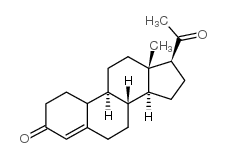19-Norpregn-4-ene-3,20-dione

19-Norpregn-4-ene-3,20-dione structure
|
Common Name | 19-Norpregn-4-ene-3,20-dione | ||
|---|---|---|---|---|
| CAS Number | 472-54-8 | Molecular Weight | 300.43500 | |
| Density | 1.1g/cm3 | Boiling Point | 447.4ºC at 760mmHg | |
| Molecular Formula | C20H28O2 | Melting Point | N/A | |
| MSDS | USA | Flash Point | 166.8ºC | |
|
Structure-activity relationships of synthetic progestins in a yeast-based in vitro androgen bioassay.
J. Steroid Biochem. Mol. Biol. 110(1-2) , 39-47, (2008) The recent identification of tetrahydrogestrinone (THG), a non-marketed designer androgen used for sports doping but previously undetectable by established mass spectrometry-based urine drug screens, and its production by a facile chemical modification of ges... |
|
|
The blood pressure and metabolic effects of 19-nor-deoxycorticosterone and 19-nor-progesterone in sheep.
Clin. Exp. Hypertens. A. 6(9) , 1591-600, (1984) The present study examines the blood pressure and metabolic effects of 5 day infusions of 19-nor-deoxycorticosterone (19-nor-DOC) and 19- nor-progesterone (19-nor-PROG) in the intact conscious sheep. Both these steroids raise blood pressure in the rat. 19-nor... |
|
|
The pharmacology of nomegestrol acetate.
Maturitas 71(4) , 345-53, (2012) Nomegestrol acetate (NOMAC) is a 19-norprogesterone derivative with high biological activity at the progesterone receptor, a weak anti-androgenic effect, but with no binding to estrogen, glucocorticoid or mineralocorticoid receptors. At dosages of 1.5mg/day o... |
|
|
Interaction of new 19 nor progesterone derivatives with progestagen, mineralocorticoid and glucocorticoid cytosolic receptors.
J. Pharmacol. 17(4) , 699-706, (1986) Structure-activity relationships were studied in vitro on a number of natural and artificial steroids in order to assess their progestagen specificity. These substances included a new compound derived from 19 nor progesterone, TX066 or nomegestrol acetate, an... |
|
|
19-Nor-corticosteroids in experimental and human hypertension.
Clin. Exp. Hypertens. A. 4(9-10) , 1851-67, (1982) Recent reports demonstrate that the 19-nor-corticosteroids (19-nor-DOC) are naturally-occurring substances in hypertensive animal models as well as man. Since some 19-nor-corticosteroids are potent mineralocorticoids, they may have a role in regulating system... |
|
|
Lack of estrogenic potential of progesterone- or 19-nor-progesterone-derived progestins as opposed to testosterone or 19-nor-testosterone derivatives on endometrial Ishikawa cells.
J. Steroid Biochem. Mol. Biol. 55(1) , 77-84, (1995) Estrogen receptors of human endometrial cancer Ishikawa cells were found to be present in moderate amounts (160-200 fmol/mg protein), and to specifically bind moxestrol (R2858) with a very high affinity characterized by a Kd around 60 pM, when measured under ... |
|
|
Experimental hypertension induced by 19-nor-progesterone treatment in the rat.
Endocrinology 109(4) , 1164-7, (1981) Fifty-day-old unilaterally nephrectomized and 1% saline-drinking Sprague-Dawley CD male rats were divided into three comparable groups on the basis of blood pressure, body weight, and fluid intake. The control group received vehicle only, the second group rec... |
|
|
Nestorone: clinical applications for contraception and HRT.
Steroids 68(10-13) , 907-13, (2003) The 19-nor derivatives of progesterone are referred to as "pure" progestational molecules as they bind almost exclusively to the progesterone receptor (PR) without interfering with receptors of other steroids. In this category is Nestorone, which has strong p... |
|
|
Mineralocorticoid and hypertensive effects of 19-nor-progesterone.
Endocrinology 109(4) , 1168-75, (1981) The mineralocorticoid potency of 19-nor-progesterone was evaluated by both its effect on electrolyte excretion in adrenalectomized animals and its ability to cause hypertension and electrolyte changes in mononephrectomized, salt-loaded rats. The mineralocorti... |
|
|
19-Nor progesterone is a mineralocorticoid agonist.
Endocrinology 109(1) , 313-5, (1981) 19-Nor progesterone (19-nor P) has previously been shown to have a approximately 3-fold higher affinity for mineralocorticoid receptors than progesterone (P), its C-19 methylated parent steroid; in contrast, 19-nor aldosterone has less than 1% the mineralocor... |